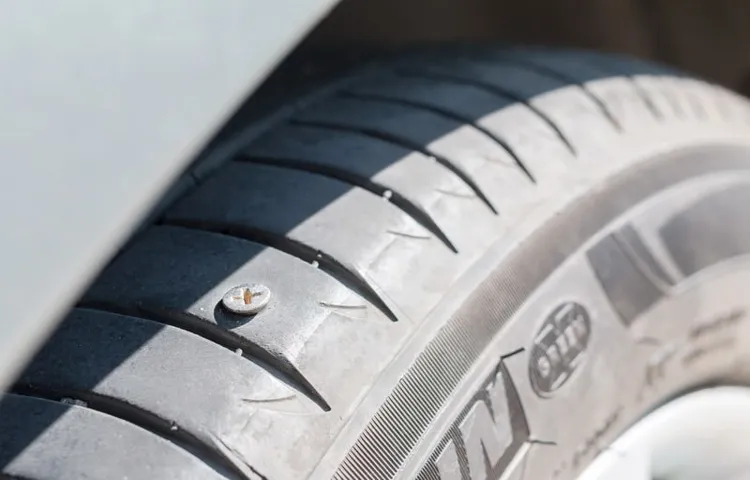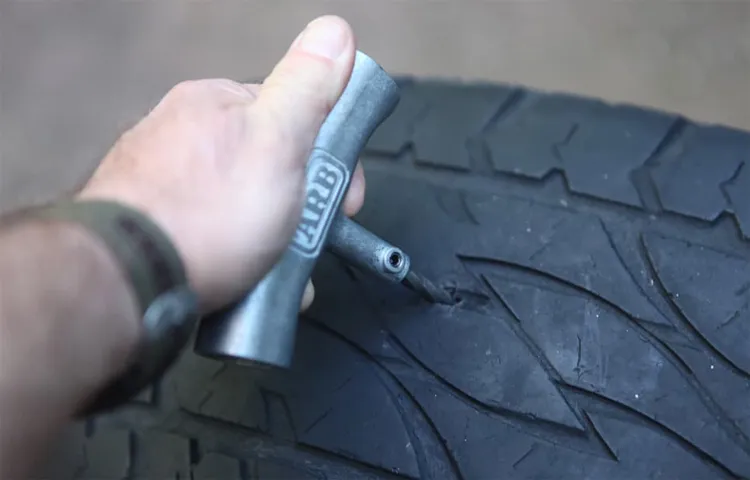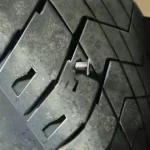Have you ever experienced a flat tire while driving? It’s definitely not a pleasant situation to be in. At times, it can take you by surprise, leaving you with many unanswered questions. One of the most common questions that come to mind is, “How long does it take for a car tire to deflate?” The answer to this question depends on various factors.
For instance, the size of the puncture, the rate of air loss, and the tire’s type and size. On average, a tire can lose air at a rate of 1-2 psi per day. However, a severe puncture can cause a complete loss of pressure in a matter of minutes.
To further understand tire deflation, it helps to think of it like a leaky balloon. Just like a balloon losing air, a tire will lose air quickly if there is a sizable puncture. On the other hand, a slower leak will take some time to lower the tire’s pressure gradually.
Overall, it’s essential to regularly inspect your tires for any punctures, bulges or cracks. Doing so can help you detect and preemptively repair any issues before they lead to a flat tire, or worse, an accident.
Table of Contents
Introduction: Punctured Car Tires
Have you ever wondered how long it takes for a punctured car tire to fully deflate? Well, the answer isn’t as straightforward as you might think. It depends on several factors, including the size and location of the puncture, the type of tire, and the weight of the vehicle. For instance, a small puncture might take several hours to fully deflate, while a larger puncture could cause your tire to lose all its air within minutes.
Additionally, a heavier vehicle will put more pressure on the tire, causing the air to escape faster. Ultimately, it’s difficult to give a specific timeline for how long it takes a punctured tire to deflate without knowing the specifics of the situation. However, one thing is for sure: if you notice a punctured tire, it’s best to get it fixed as soon as possible to avoid further damage and the risk of a blowout while driving.
What Happens When You Get a Punctured Car Tire?
If you’ve ever experienced a punctured tire while driving, you know how frustrating it can be. A punctured tire can occur due to various reasons, including sharp objects on the road, worn-out tires, and over-inflation. When you get a punctured car tire, the first thing you may notice is a sudden decrease in your vehicle’s handling and stability.
Your car may start to pull to one side, and you may hear a loud hissing sound. It’s essential to address a punctured tire promptly, as driving on a flat tire can damage your vehicle’s rims and cause the tire to blowout. The good news is that most punctured tires are repairable, and you can be back on the road in no time.
However, in some cases, you may need to replace the tire if the puncture is too severe or located on the tire’s sidewall.

How Does a Car Tire Deflate?
Car tire deflation is a common issue experienced by drivers, often caused by punctures on the tire’s surface. A damaged tire can potentially bend or puncture due to a sharp object on the road or excessive wear and tear. When this happens, air leaks from the tire and causes a drop in its pressure.
This results in a deflated tire, causing a bumpy and unstable ride, and can even lead to dangerous situations on the road. If you notice a sudden drop in tire pressure, it’s crucial to check your tires immediately and take necessary action to ensure your safety and that of your passengers. Regular tire checks and maintenance can help prevent unexpected deflation and ensure a smooth and secure driving experience.
Factors That Affect Deflation Time
Have you ever wondered how long it takes for a punctured car tire to deflate? Well, the answer is not as straightforward as you might think. Several factors affect how quickly a tire deflates after it is punctured. First and foremost, the size and position of the puncture play a significant role.
A small hole in the tread might take several hours to deflate, while a larger puncture in the sidewall could cause rapid deflation within minutes. Tire pressure also affects how fast a tire deflates. If the tire is already underinflated, it will lose air faster than a tire with proper air pressure.
Additionally, the weight of the vehicle and the temperature can impact the deflation time, as heavier vehicles will cause the tire to deflate faster, and high temperatures can speed up the expansion of the hole. Lastly, the type of tire plays a role, as run-flat tires and high-performance tires may have features that slow down the deflation process. So, while there is no definitive answer to how long it takes for a punctured tire to deflate, we can safely say that there are several factors that can affect it.
Size and Type of Tire
When it comes to tire deflation time, there are several factors that can affect how quickly your tires lose air. One of the main factors is the size and type of tire you have. Generally, larger tires with a larger volume of air will take longer to deflate than smaller tires.
Additionally, the type of tire you have can also play a role in deflation time. For example, tires made with thicker or more durable materials may take longer to deflate than tires made with thinner materials. Other factors that can affect deflation time include the temperature and altitude at which your tires are operating, as well as the quality of the valve stem and the condition of the tire itself.
By understanding these factors and regularly checking your tire pressure, you can ensure that your tires stay properly inflated and maintain optimal performance on the road. Keep in mind that even small changes in tire pressure can have a significant impact on your vehicle’s handling and fuel efficiency, so it’s important to stay on top of tire maintenance to keep your car running smoothly.
Severity of Puncture
The severity of a puncture plays an important role in how quickly your tire deflates. A small puncture, such as a nail or screw, may take longer to release air than a larger puncture like a jagged piece of broken glass. Other factors that affect deflation time include the tire’s size and construction, the air pressure at the time of puncture, and the type of surface the puncture occurred on.
For example, a puncture on a soft surface like mud or sand may release air more slowly than one on a hard surface like asphalt. Additionally, the angle of the puncture can play a role. A puncture that is perpendicular to the tire’s tread will typically release air more quickly than one that is at an angle.
Overall, the severity of the puncture and the conditions surrounding it will impact how quickly your tire deflates. It’s important to address any punctures as soon as possible to avoid a flat tire and potential safety issues on the road.
Temperature and Weather Conditions
When it comes to deflating an inflatable object, a common question that comes to mind is how long it will take for it to fully deflate. In truth, there are a couple of factors that can affect deflation time, one of which is temperature. When the temperature is warmer, the air inside the inflatable will expand, causing it to take longer to deflate.
On the other hand, when the temperature is colder, the air will contract, meaning the inflatable will deflate more quickly. Another factor that can impact deflation time is weather conditions. Windy weather can cause the inflatable to move around, creating resistance to air escaping and leading to a slower deflation time.
Conversely, calm weather can help the air escape more easily, leading to a quicker deflation. In conclusion, understanding these factors can help you better plan for the time it takes for an inflatable to deflate and make sure you’re prepared for the situation.
Average Deflation Rate
Have you ever wondered how long it takes for a punctured car tire to deflate? The average deflation rate for a tire with a small puncture is around 1-2 PSI (pounds per square inch) per hour. However, this can vary depending on the size of the puncture and the type of tire. For example, a larger puncture or a thinner sidewall may result in a faster deflation rate.
Additionally, factors such as temperature and altitude can also affect the rate at which a tire deflates. It’s important to keep in mind that driving on a flat or severely underinflated tire can cause damage to the tire and the wheel, and can even lead to a blowout. Therefore, if you notice that your tire is losing air, it’s important to have it repaired or replaced as soon as possible to ensure your safety on the road.
So, if you have a punctured tire, it’s best to get it fixed right away!
Measurement and Calculation
The average deflation rate is an important economic indicator that measures the rate at which prices of goods and services decrease over time. This metric is calculated based on the Consumer Price Index (CPI), which measures the average changes in prices of a basket of goods and services consumed by households. A negative deflation rate means that prices are decreasing over time, while a positive deflation rate indicates that prices are increasing.
The average deflation rate is useful for businesses and consumers because it helps forecast future economic conditions, especially in times of economic downturns. It also provides a basis for policymakers to formulate monetary policies to address inflation and deflation concerns. Therefore, tracking the average deflation rate is important for anyone interested in understanding the current state of the economy and making informed financial decisions.
Conclusion and Takeaways
In conclusion, the average deflation rate is a vital metric that economic policymakers keep a keen eye on. As opposed to inflation, deflation leads to decreased consumer spending, which adversely affects economic growth. Understanding the causes and effects of deflation is crucial to ensure stable economies and prevent the growth of economic bubbles.
It is imperative to note that even though deflation might seem beneficial to consumers, it potentially harms economic growth and renders long-term investments unprofitable. Hence, policymakers should aim to maintain a healthy bank rate and inflation rate to steer clear of deflation. As consumers, we should actively seek to make wise purchase decisions and avoid over-saving our money, which fuels deflation.
By maintaining a steady economy, we can all enjoy a more stable financial future.
Conclusion
In conclusion, the time it takes for a punctured car tire to deflate depends on a variety of factors such as the size of the puncture, the pressure in the tire, and the weight of the vehicle. However, one thing is for sure – it always seems to happen at the most inconvenient moment. So, if you want to avoid the frustration of being stranded on the side of the road with a flat tire, be sure to keep your tires properly inflated and always carry a spare.
Remember, a stitch in time saves nine, or in this case, a timely repair could save you from a deflated day.”
FAQs
Can a punctured car tire take a long time to deflate completely?
Yes, depending on the size of the puncture, a punctured car tire can take anywhere from minutes to hours to deflate completely.
What are the signs of a punctured car tire?
Signs of a punctured car tire may include a noticeable hissing sound, a bulge or sidewall damage, vibration or shaking while driving, or a sudden loss of tire pressure.
What causes a punctured car tire?
A punctured car tire can be caused by a variety of things, such as a sharp object on the road, overinflated tires, underinflated tires, or worn-out tires that have lost their tread.
Is it safe to drive on a punctured car tire?
No, it is not safe to drive on a punctured car tire. It can lead to further damage to the tire and potentially cause an accident.
Can a punctured car tire be repaired?
Yes, a punctured car tire can be repaired if the puncture is small and located in the tread area. However, if the puncture is in the sidewall or too large, the tire may need to be replaced.
How long does it take to repair a punctured car tire?
The time it takes to repair a punctured car tire can vary, depending on the severity of the damage and the availability of repair services. It can take anywhere from 15 minutes to several hours.
How long does it take for a punctured car tire to lose all air pressure?
The time it takes for a punctured car tire to lose all air pressure can vary, depending on the size of the puncture, the type of tire, and the weight of the vehicle. It can take anywhere from a few minutes to several hours.



